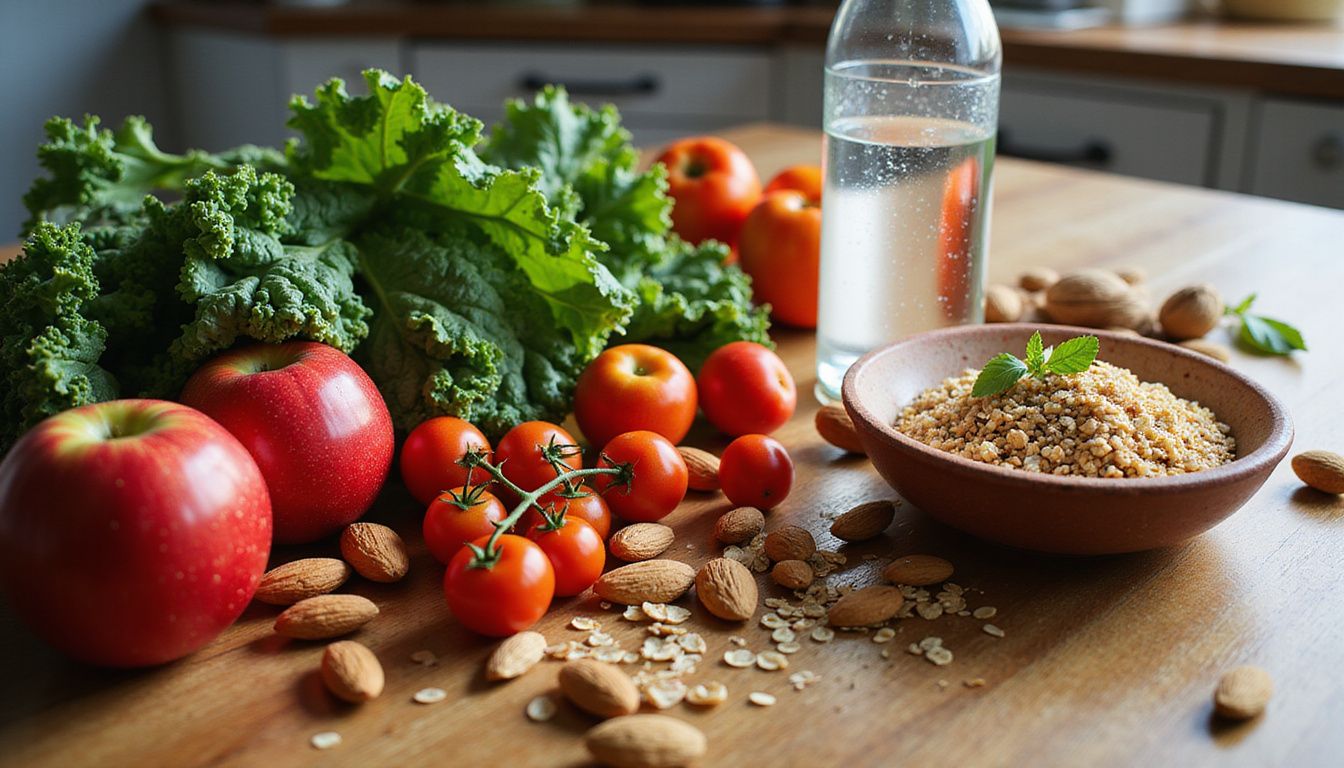Dr. Oz Weight Loss Plan: Shed Pounds With Expert-Recommended Strategies
Our Nutrition Assistant AI Suite will transform your body. You will lose fat, get toned, and build muscle. Gain confidence and optimal health.
Struggling to lose weight and keep it off? The Dr. Oz weight loss plan highlights whole foods, lean proteins, and fewer sugars to drive steady results. These expert-guided ideas from Mehmet Oz focus on a balanced diet, daily movement, and simple habits that fit real life.
Curious whether this weight loss plan fits your health goals? Keep reading for clear steps, potential benefits, and risks you should weigh first.
Key Takeaways
- The plan centers on whole foods, plant proteins, and healthy fats, while limiting processed snacks, added sugars, animal protein, and most dairy for safer weight loss (BMJ 2024, Cleveland Clinic 2023).
- Structured options like Total 10 claim up to 10 pounds lost in two weeks by cutting calories and simple carbs (“The Doctor Oz Show,” DoctorOz.com).
- Daily activity matters. Aim for 30 minutes of moderate exercise and reduce nighttime snacking to support long-term weight management (Harvard Health Publishing 2023).
- Nutrition experts support whole foods, but say detoxes and “miracle” supplements lack strong evidence or FDA support.
- Consult a healthcare provider before starting due to restrictive rules and debated supplement use. Some parts of the plan do not have strong scientific backing.

What is the Dr. Oz Weight Loss Plan?

The Dr. Oz Weight Loss Plan uses evidence-based habits to help you manage weight safely. It focuses on whole foods, plant-based proteins such as beans and tofu, healthy fats like olive oil and avocado, and low-glycemic carbohydrates from whole grains and legumes.
It also encourages you to limit processed snacks, added sugars, animal protein, and most dairy. These steps may lower inflammation and help control appetite.
There are several programs within Oz’s approach. The Total 10 Rapid Weight Loss Plan claims up to 10 pounds lost in two weeks through calorie cuts and removing simple carbs1. The 21-Day Diet Plan aims to jump-start fat loss, then transitions you into a steady routine2. The 28-Day Shrink Your Stomach Challenge pairs a structured eating plan with a daily plank routine3.
Each program promotes nutrient-dense foods and may lower the risk of diabetes, heart disease, and abdominal obesity linked to poor diet quality4.
References:
- 1) “The Doctor Oz Show: The Total 10 Rapid Weight-Loss Plan,” DoctorOz.com
- 2) “21-Day Weight-Loss Breakthrough Diet,” DoctorOz.com
- 3) “28-Day Shrink Your Stomach Challenge,” DoctorOz.com
- 4) “Nutrition Interventions for Healthy Patients: Preventing Diabetes & Heart Disease,” Journal of Family Practice
Key Components of Dr. Oz’s Weight Loss Techniques
These methods focus on simple actions you can repeat every day. Small choices add up to meaningful progress.
How does prioritizing whole, unprocessed foods aid weight loss?
Whole, unprocessed foods tend to be lower in added sugars and empty calories. A 2024 BMJ review linked high intake of ultra-processed foods to weight gain and higher disease risk. Choosing vegetables, fruit, beans, eggs, fish, and other simple items helps you avoid hidden additives.
Limiting refined grains and sugary foods supports steadier blood sugar, which may improve insulin resistance. The Cleveland Clinic notes that higher fiber and water content in whole foods helps you feel satisfied on fewer calories.
Nighttime snacking gets easier to control when meals are rich in fiber and protein. Harvard Health Publishing advises avoiding late-night eating to support weight management.
Why increase protein, vegetables, and healthy fats?
Protein supports muscle health and a higher resting calorie burn. Choose poultry, fish, eggs, beans, lentils, or hummus. Pair protein with complex carbs for steady energy and a modest metabolism boost.
Nonstarchy vegetables like cucumbers, tomatoes, asparagus, and celery add volume, vitamins, and minerals without many calories. They help you stay full.
Healthy fats from olive oil, avocado, nuts, and nut butter support heart health and satiety. The 21-Day Plan often suggests three servings of plant proteins daily and two tablespoons of olive oil. Dietitians frequently highlight this mix for sustainable eating.
How to reduce simple carbohydrates and sugars effectively?
- Remove white flour and white sugar from your cart. This reduces blood sugar spikes.
- Stick to one serving of whole grains daily, for example, sprouted grain bread.
- Avoid refined sugars, artificial sweeteners, and highly processed snacks.
- Replace sugary breakfast items with eggs, beans, or a veggie-packed plate.
- Build meals around salads, leafy greens, olive oil, and avocado.
- Choose water, coffee, or green tea instead of sweetened drinks.
- Read labels to spot added sugars and high-glycemic ingredients.
- Skip high-glycemic foods like pastries and candy to support weight control.
- Satisfy a sweet tooth with a citrus splash or a small piece of fruit.
- Check in with your clinician or a registered dietitian for guidance.
I swapped flavored granola bars for a handful of nuts and green tea in the morning. Energy improved, and mid-morning sugar cravings faded.
What daily exercise is recommended for weight loss?
Aim for at least 30 minutes of moderate aerobic exercise most days. Brisk walking, biking, or swimming can raise your heart rate and burn calories.
Add strength training two or three times per week to build muscle. Muscle tissue burns more calories at rest, which supports weight loss over time.
The 28-Day Challenge often includes daily planks for core strength. Short high-intensity interval training, or HIIT, mixes quick bursts of effort with rest. Research suggests it can deliver results in less time than steady cardio.
When I added daily walks and simple bodyweight moves to a structured eating plan, I felt more alert and focused during work hours.
Dr. Oz Weight Loss Programs Overview
These programs offer set rules that can remove guesswork. Clear rules can make new habits simpler to follow.
What is the Total 10 Rapid Weight Loss Plan?
Total 10 claims up to 10 pounds lost within two weeks. It eliminates simple carbs including refined sugars and highly processed foods to lower calorie intake.
The plan allows unlimited nonstarchy vegetables, plant-based proteins, and healthy fats such as olive oil and avocado, plus limited low-fat dairy. It discourages eating between 8 p.m. and 8 a.m. to reduce late-night snacking.
It suggests a multivitamin and vitamin D. A vegetable broth appears as a “detox” staple, and some people use Epsom salt baths to relax. Focus remains on whole foods and limited animal protein.
Keeping dinner to nonstarchy vegetables with lean protein helped me reduce cravings later at night. Planning leftovers made lunch prep easier the next day.
How does the 21-Day Diet Plan work?
For three weeks, you emphasize plant proteins, nonstarchy vegetables, and healthy fats. Many versions include three servings of plant proteins, two servings of fruit, and one serving of whole grains each day.
Calcium sources and other key minerals support daily needs. Animal protein and dairy are limited to about two servings per week, with Greek yogurt often the main dairy choice.
Two cups of oolong tea are suggested to support alertness. Removing simple carbs helps stabilize energy. Daily movement strengthens results and supports weight control.
Consistency with meal prep and two cups of oolong tea helped me curb afternoon snacking. After 21 days, you shift toward a balanced, lower-calorie routine.
What is the 28-Day Shrink Your Stomach Challenge?
This challenge pairs a structured meal plan with a daily plank routine for core strength. It stresses meal prep, hydration, and sleep as part of your plan.
Simple carbs are removed, while vegetables and protein become the base of each meal. A detailed schedule outlines what to eat at each meal to reduce decisions and processed items.
The week-to-week approach builds habits in manageable steps. Many people like the clear structure and the day-by-day plank progression.
Next, see the foods this plan recommends most often and why they matter for your results.
Which Foods Are Recommended in Dr. Oz’s Weight Loss Plan?
Food choices drive outcomes. These options support steady energy, better hunger control, and a healthier metabolism.
Why focus on non-starchy vegetables?
Nonstarchy vegetables, such as cucumbers, tomatoes, asparagus, and celery, sit in the “unlimited” group. They are low in calories and have a low glycemic load, so they help you feel full without adding many calories.
Research suggests people who eat more nonstarchy vegetables tend to lose more weight over time. They pack fiber, vitamins, and minerals and are easy to add to any meal or snack.
Keeping sliced tomatoes and cucumbers on hand helped me avoid high-calorie snacks in the afternoon.
How to include plant-based proteins in your diet?
Target three servings of plant proteins daily. Beans, lentils, tofu, tempeh, and seeds are easy options. Add lentils to soup or chickpeas to salads for a quick upgrade.
Hummus works well as a snack or sandwich spread. Greek yogurt also provides protein, though it is dairy, so check your plan’s limits.
Make plant proteins the default choice and keep meat as a smaller part of the week. Studies link plant-forward patterns with better heart health and sustainable weight management.
What healthy fats should you choose like avocado and olive oil?
Pick fats like avocado, olive oil, nuts, nut butter, and olive-based dressings. These provide unsaturated fats that support heart health and satiety.
Many versions allow up to half an avocado per day and two tablespoons of olive oil. Research links olive oil to improved cholesterol profiles when used in place of saturated fat.
Using mashed avocado in a lunch bowl kept my afternoon cravings in check. Choosing the right fats helps you avoid overeating refined snacks later.
Why choose whole grains and legumes?
Whole grains and legumes deliver complex carbs, fiber, and protein. One serving of whole grains per day fits many versions of the plan. Legumes like lentils and chickpeas help steady blood sugar and increase fullness.
Studies associate whole grains and legumes with lower body weight compared with refined carbs. Many educators recommend them for people reducing simple sugars.
Try brown rice or quinoa with beans or lentils. This approach reduces the need for unproven pills and quick-fix claims.
Should you limit animal protein and dairy intake?
Many versions of the plan limit animal protein and dairy to two servings per week. Greek yogurt often appears as the main dairy option. The rest of your protein comes from plants.
Keeping saturated fat lower may support heart health and calorie control. Many people find it easier to meet protein goals with beans, lentils, and tofu when they plan ahead.
Which Foods Should You Avoid on Dr. Oz’s Plan?
Some foods make it harder to reach your goals. Removing these can reduce cravings and extra calories.
Why avoid refined sugars and artificial sweeteners?
White sugar and artificial sweeteners can fuel cravings and overeating. Cutting them often helps people feel fuller and reduces snack urges.
Some “fat-burning” products, such as green coffee bean extract, appear online with bold promises. Many lack strong evidence or quality safety data.
When I dropped diet soda with artificial sweeteners, I snacked less during long workdays. Reducing added sugars supports a steadier metabolism.
What processed foods and snacks to eliminate?
Remove ultra-processed foods like candy, chips, packaged pastries, and many frozen meals. These often combine refined sugar, unhealthy fats, and salt.
Common pitfalls include flavored nuts with added sugar, boxed cookies and crackers, sugary bars, and high-sodium snacks. These add calories fast but give little nutrition.
Replacing these with fruit, nuts, or yogurt helped me stay full between meals and avoid a late-day energy slump.
How to cut out high-glycemic carbohydrates?
Start by removing white bread, white flour, and sweetened products. High-glycemic foods spike blood sugar quickly, which can increase hunger later.
Limit yourself to one serving of whole grains per day, as many plans suggest. Replace refined bread or pastries with leafy greens or other nonstarchy vegetables.
After I swapped bagels and pasta for salads and beans, my energy stayed more even through the afternoon. Research supports this approach for better weight management and stable blood sugar.
Reference: Ludwig DS et al., JAMA 2012;308(7):708-717
Why stay away from trans fats and unhealthy oils?
Trans fats raise bad cholesterol and lower good cholesterol. Even small amounts increase heart risk. In 2015, the FDA said artificial trans fats are unsafe for regular use.
The plan discourages butter and fried foods, and it emphasizes oils like olive or avocado oil. Many studies support replacing unhealthy fats with unsaturated fats to improve health markers.
Switching from fried items to olive oil at home improved my energy and digestion across the week.
What Are the Advantages of the Dr. Oz Weight Loss Plan?
This approach builds practical habits you can keep. The goal is weight control that feels realistic, not punishing.
How does it foster sustainable lifestyle changes?
Meal planning and prep lower guesswork during busy days. These habits help you choose healthy options without relying on willpower alone.
Discouraging nighttime snacking reduces extra calories, which can support long-term results. Following a set meal schedule makes it easier to avoid impulse eating.
Over time, these small changes create a routine you can maintain. Consistency turns healthy choices into normal daily behavior.
How does it support balanced nutrition?
The plan emphasizes nonstarchy vegetables, lean or plant-based proteins, and healthy fats. This mix provides fiber, vitamins, minerals, and steady energy without many empty calories.
Three meals and one or two planned snacks can steady blood sugar. Large portions of nonstarchy vegetables and adequate protein help curb hunger.
Limiting simple sugars keeps energy more stable through the day. A broader mix of food groups supports complete nourishment.
How does it enhance metabolism and energy levels?
Suggested drinks like oolong tea may boost alertness due to caffeine and antioxidants. Green tea and warm lemon water can support hydration and daily routines that encourage calorie burn.
These simple habits, plus regular exercise, encourage your body to use fat for fuel. Many people feel more focused when they pair them with a balanced meal plan.
I replaced a second coffee with oolong tea before lunch. Afternoon focus improved, and my activity level rose.
What Are the Challenges and Critiques of the Dr. Oz Weight Loss Plan?
Some claims have drawn pushback from researchers and clinicians. Review the evidence before you follow any bold promise.
What are the controversies around “miracle” weight loss claims?
Dr. Oz has discussed “miracle” products on television and online. In 2014, a Senate panel questioned the promotion of quick-fix pills without strong science.
The Federal Trade Commission warns against products that promise weight loss without diet or exercise. The Food and Drug Administration has also flagged safety issues for some supplements.
I once tried a hyped extract I saw online and lost only a few pounds. Fast promises often fade when applied in daily life.
Is there scientific evidence supporting all recommendations?
Not every recommendation in this weight loss plan has solid evidence. For example, vegetable broth “detoxes” and Epsom salt baths lack clear proof of health benefits.
A British Medical Journal analysis reported that much of the advice on a popular TV show did not align with strong research. Some tips feel helpful, but the science may be limited.
This gap is why many experts advise careful review and professional guidance before trying strict protocols.
How dependent are some programs on supplements?
Some versions include a multivitamin and vitamin D. The 21-Day Plan highlights oolong tea as a daily add-on.
Even so, most of the focus stays on whole foods, sleep, and movement. There is limited evidence that the suggested supplements improve weight loss for most people.
Center your efforts on eating patterns, not pills. Food and consistent habits do the heavy lifting.
What Do Experts Say About Dr. Oz’s Weight Loss Methods?
Keri Glassman, RD, notes that detox diets in this plan are not necessary for most people. Your liver and kidneys already handle detoxification.
Chrissy Carroll, RD, MPH, finds the 21-Day Diet nutrient-dense, but too restrictive for long-term use. Surgical experts stress medical oversight if you consider procedures for weight control.
Many professionals agree on the strengths, such as whole foods and exercise. They still recommend checking in with a clinician before starting.
How to Determine if the Dr. Oz Weight Loss Plan Is Right for You?
Compare your current routine with the rules in this weight loss plan. A short self-check helps you choose a plan that fits your life.
How to evaluate your health needs and goals?
Track what you eat and how you move for a week. Write down portions, times, and activity minutes. Patterns will stand out, which guides your next steps.
Set clear goals that match your age, weight, and medical history. Use a target calorie range from a trusted source and adjust for your activity level.
After a health scare in 2020, I used a simple checklist to match goals with daily actions. That shift made progress visible and motivating.
Why consult a healthcare professional before starting?
Everyone’s body is different. A healthcare professional can flag risks tied to strict plans, especially if you have a chronic condition or take medication.
Large diet changes can affect blood pressure, blood sugar, or digestion. Medical guidance helps protect your health while you work on weight loss.
Professional support increases safety and can improve outcomes. It also gives you a clear plan for monitoring progress.
Conclusion
The Dr. Oz weight loss plan centers on whole foods, balanced meals, and daily activity. These habits can help you lose weight safely, especially when the strategy fits your lifestyle.
Before you begin, talk with your clinician to confirm the plan matches your needs. With consistent effort and the right support, your weight loss plan can become a long-term health win.
FAQs
1. What are the main strategies in the Dr. Oz Weight Loss Plan?
The Dr. Oz Weight Loss Plan uses expert-recommended strategies such as balanced nutrition, regular physical activity, and portion control. The plan encourages eating whole foods, lean proteins, fruits, and vegetables. It also suggests tracking progress and setting realistic goals. These steps are supported by clinical studies that show their effectiveness for long-term weight management.
2. How does the Dr. Oz Weight Loss Plan address calorie intake and nutrition?
This plan focuses on reducing calorie intake while maintaining proper nutrition. It recommends nutrient-dense foods that provide vitamins, minerals, and fiber. For example, a daily meal plan may include 1,500 to 1,800 calories, with a breakdown of 45 percent carbohydrates, 30 percent protein, and 25 percent healthy fats. These guidelines help support healthy weight loss and prevent nutritional deficiencies.
3. Are there any scientific studies supporting the Dr. Oz Weight Loss Plan?
Yes, the strategies in this plan are based on evidence from peer-reviewed research. Studies show that combining calorie control, increased physical activity, and behavioral changes leads to greater weight loss than diet alone. For instance, a 2020 study in the Journal of Nutrition found that participants following similar plans lost an average of 10 pounds over 12 weeks.
4. Can the Dr. Oz Weight Loss Plan be adapted for different lifestyles?
The plan is flexible and can fit various routines and preferences. It allows adjustments for dietary restrictions, cultural food choices, and activity levels. Many people find success by tailoring the plan to their own needs. For example, someone with a busy schedule can prepare meals in advance or choose quick, healthy snacks. This adaptability helps users maintain progress over time.







